Table of Contents
Types of Shrubs for Every Garden Style
Creating the perfect garden is all about choosing the right plants. Whether you want a formal or wild look, shrubs can make it happen. This guide will help you find the best shrubs for your garden.
Evergreen shrubs add beauty all year, while deciduous ones shine with seasonal colors. Knowing what each garden style needs helps you pick the right plants. Get ready to turn your garden into a space that shows off your style.
Popular Types of Shrubs: Which One Is Right for You?
Polpular types of shrubs :
Boxwood Shrub
Boxwood shrubs are renowned for their dense foliage and versatility, making them a staple in formal gardens. These shrubs can be meticulously shaped into elegant hedges or ornamental topiaries, adding sharp, structured lines to landscapes. They are ideal for creating low-maintenance, aesthetically pleasing garden designs with a refined appearance.
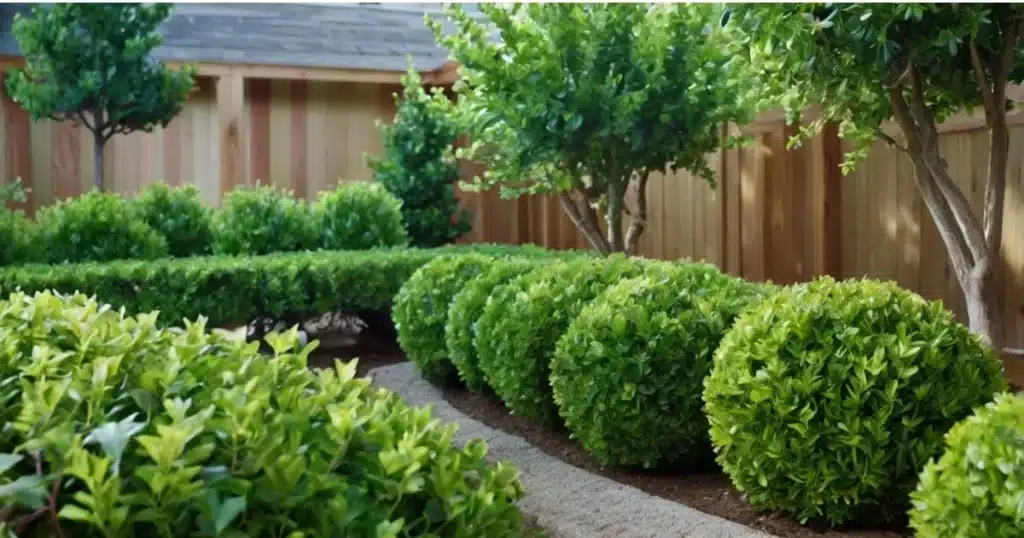
Boxwoods thrive in well-drained, slightly acidic soil and are adaptable to various lighting conditions, performing well in both full sunlight and partial shade. For best results, prune them after new growth appears to maintain their shape and encourage healthy foliage. With their slow-growing and dense nature, they require minimal upkeep, making them a practical choice for busy gardeners.
Popular varieties of boxwood include the classic English Boxwood, prized for its traditional look, and Japanese Boxwood, known for its resilience and compact growth habit. Whether used for edging, privacy, or decorative features, boxwoods are a timeless choice for enhancing any garden’s elegance and structure.
Juniper Shrub
Juniper shrubs, among the most adaptable types of shrubs, are a versatile evergreen option, providing lush greenery throughout the year. Known for their hardiness, they thrive in a wide range of climates, from frigid winters to scorching summers, making them an excellent choice for gardens in challenging environments. Their adaptability and resilience make them ideal for low-maintenance, drought-resistant landscapes.
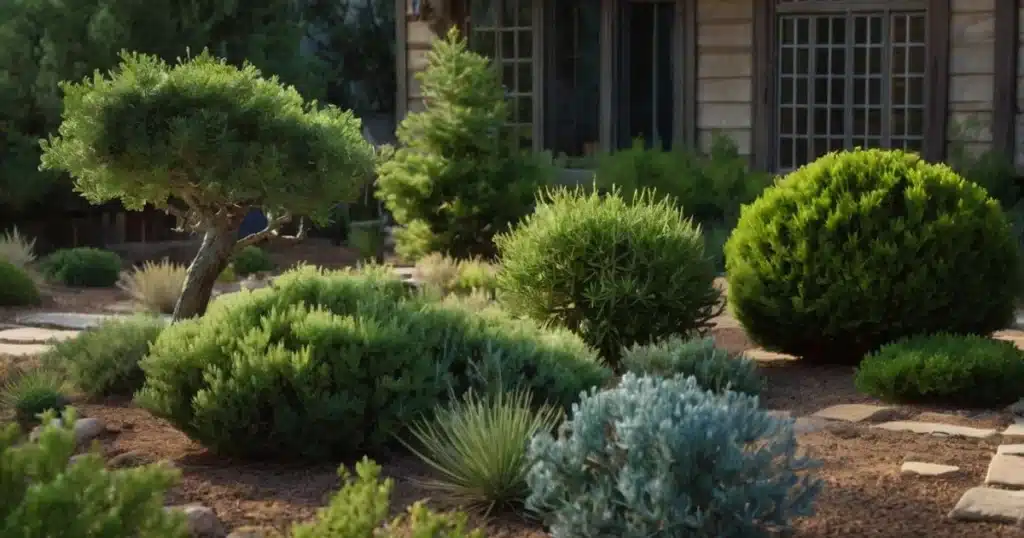
Junipers prefer sandy, well-drained soil and flourish in full sun. Once established, they require minimal watering, making them a practical choice for gardeners seeking water-wise solutions. With their rapid growth habits, junipers can spread quickly, serving as effective ground covers or taking on a more shrub-like appearance, depending on the variety.
Popular varieties include the Common Juniper, valued for its classic upright form, and the Creeping Juniper, which is perfect for covering large areas or slopes with ease. Whether you’re looking to add structure, greenery, or ground cover to your garden, juniper shrubs are a reliable and attractive solution.
Ninebark Shrub
Ninebark shrubs are admired for their striking appearance, featuring exfoliating bark that reveals layers of texture and clusters of white or pink flowers that enhance their visual appeal. These unique characteristics make ninebark an excellent choice for gardeners seeking low-maintenance plants with standout features.
This shrub thrives in moist, well-drained soil and performs well in both full sunlight and partial shade. Its adaptability makes it easy to grow in a variety of settings, and it is notably tolerant of hard pruning, allowing gardeners to shape and manage it as needed. With its upright growth habit and arching branches, ninebark adds depth and structure to any landscape.
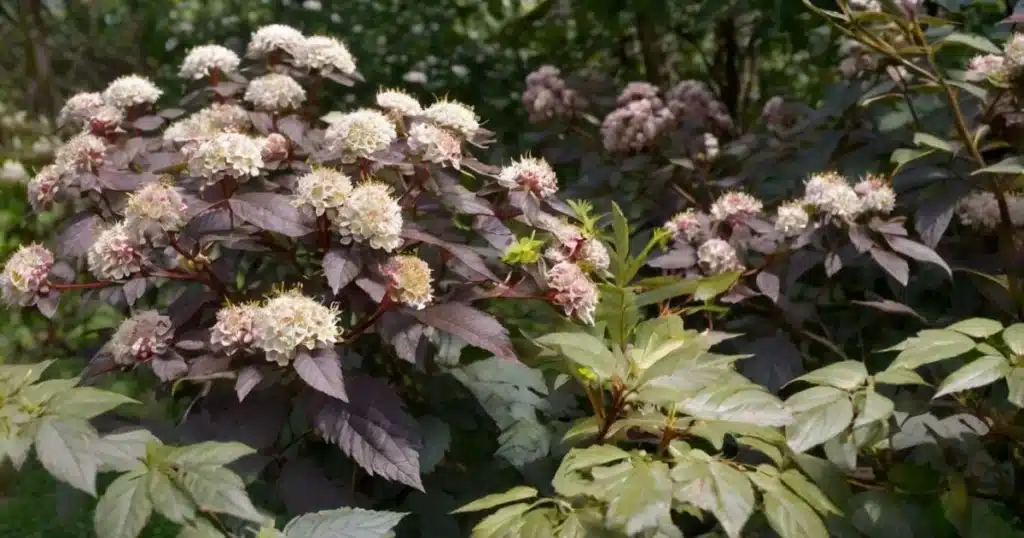
Popular varieties include Diablo Ninebark, which boasts deep burgundy foliage, and Little Devil Ninebark, a more compact option perfect for smaller spaces. Whether used as a focal point or a complementary feature, ninebark shrubs bring a combination of elegance and resilience to gardens.
Sweetshrub
Sweetshrub, one of the most distinctive types of shrubs, is cherished for its spicy-sweet fragrance, with blooms that emit a scent reminiscent of strawberries. Its unique maroon to reddish-brown flowers make it a standout choice for gardens where fragrance and striking blossoms are a priority.
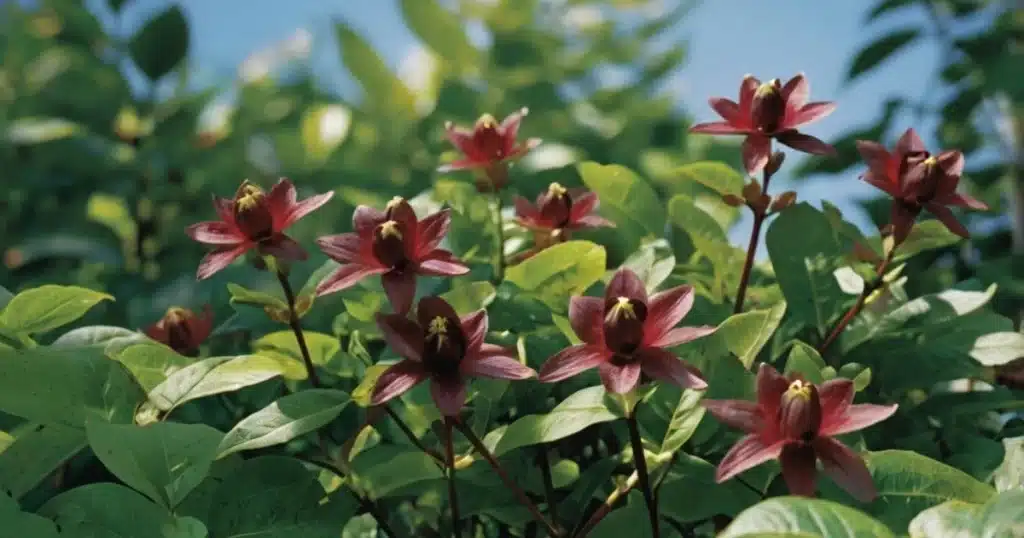
This shrub thrives in moist, well-drained soil with a slightly acidic pH and can adapt to various lighting conditions, performing well in both partial shade and full sunlight. Moderate watering keeps it healthy, especially during dry spells. Sweetshrub is a deciduous plant, with dark green foliage that transitions to a vibrant yellow in the fall, adding seasonal interest to the garden.
A popular variety is A. floridus, commonly known as Carolina Allspice, which is loved for its rich aroma and adaptability. Sweetshrub is an excellent choice for adding sensory appeal and unique charm to any landscape.
You can also add a touch of originality to your garden with exotic shrubs. Like:
Banana shrub (Calycanthus)
The banana shrub offers burgundy-red flowers with a delicious banana-like scent. It thrives in well-drained soil and partial shade, making it a unique addition to any garden
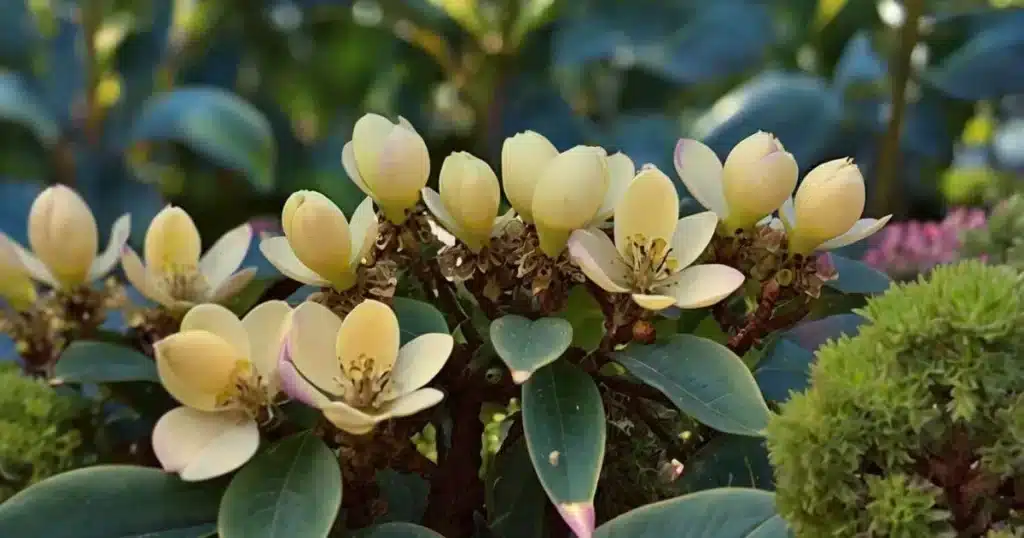
Mexican Honeysuckle
Mexican Honeysuckle is a stunning shrub known for its vibrant orange to red flowers, which instantly bring a tropical flair to any garden. Its bright, tubular blooms not only add visual appeal but also attract hummingbirds, making it a favorite for wildlife-friendly landscapes.
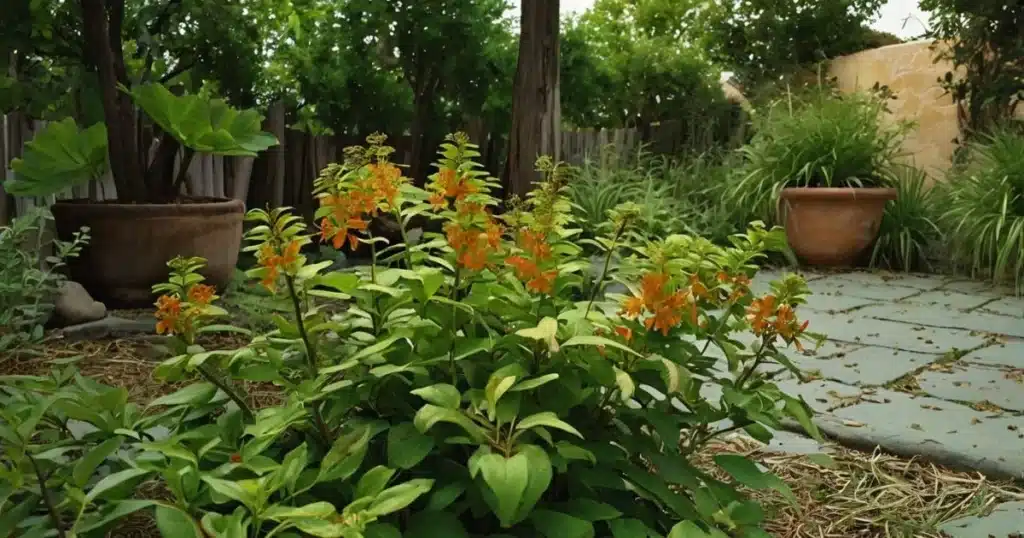
This shrub thrives in well-drained, slightly acidic soil and requires full sun to produce its best blooms. Regular watering is essential, especially during hot months, to maintain its lush appearance and consistent flowering. Depending on the climate, Mexican Honeysuckle can be evergreen or semi-evergreen, and it has a spreading growth habit, making it ideal for filling garden spaces with ease.
A popular variety is Tecomaria capensis, valued for its bold color and adaptability. Whether used as a border, a colorful accent, or a wildlife attractor, Mexican Honeysuckle is a versatile choice for enhancing gardens with warmth and vitality.
Chinese orange blossom (Osmanthus)
Known for its fragrant white flowers, the Chinese orange blossom adds a refreshing aroma to your garden. It thrives in both full sunlight and partial shade..

Shrubs and Biodiversity: How to Choose Plants to Support Local Wildlife
Gardens are not only spaces for relaxation and beauty, but they also play a crucial role in preserving biodiversity. Shrubs, in particular, can be valuable allies in attracting and supporting local wildlife. Whether for pollinators, birds, or beneficial insects, choosing the right shrubs can turn your garden into an ecological sanctuary.
Why Shrubs Are Essential for Biodiversity
– Providing Food: Many shrubs produce fruits, berries, and nectar that feed birds, bees, and other pollinators.
– Offering Shelter and Refuge: Dense-leaved shrubs provide shelter from the weather and a safe place for nesting.
– Supporting the Local Ecosystem : Well-chosen shrubs can attract beneficial insects, which in turn promote pollination and natural pest control.
Which types of Shrubs to Choose to Support Local Wildlife?
Shrubs for Pollinators
To support local wildlife, choosing the right shrubs is essential. This type of shrubs includes Lavender (Lavandula), Elder (Sambucus), and Honeysuckle (Lonicera), which are excellent for pollinators.Their fragrant flowers attract bees, butterflies, and other pollinating insects, ensuring a steady supply of nectar throughout the seasons.
Shrubs for Birds
For bird-friendly gardens, consider shrubs such as Holly (Ilex aquifolium), Strawberry Tree (Arbutus unedo), and Larch (Larix).This type of shrubs not only enhances biodiversity but also creates a haven for birds. Holly provides dense cover, offering shelter during winter, while the berries of the Strawberry Tree nourish birds. Larch, although a tree, makes a great shrub in its younger form and its cones are a favorite among many bird species.
Shrubs for Beneficial Insects
Lastly, for promoting beneficial insects, shrubs like Cistus, Dogwood (Cornus), and Fuchsia are ideal. This type of shrubs not only enhances the garden’s appeal but also supports pollinators.Cistus attracts bees, while Dogwood supports dragonflies and aquatic insects, particularly when placed near water features. Fuchsia, with its bright flowers, draws both hummingbirds and other pollinators, making it a vibrant addition to any garden.
How to Integrate Shrubs for Biodiversity into Your Garden?
- Mix Varieties: Create a diverse plant palette with shrubs of different sizes and shapes to attract a variety of wildlife.
- Place Shrubs Strategically: Use shrubs to form hedges or natural screens that provide shelter for animals.
- Favor Native Varieties: Local plants are adapted to your climate and are more likely to attract and nourish local wildlife.
Shrubs play a key role in landscaping around trees. Discover our landscaping around trees ideas to maximize biodiversity and enhance the beauty of your green space.
Ecological Maintenance of Shrubs to Preserve Wildlife
To maintain a healthy environment for local wildlife, it is important to use gentle pruning methods. Trim your shrubs carefully, ensuring that you don’t harm the natural habitats of insects and birds. Avoid the use of chemical pesticides, as these can disrupt the delicate ecological balance. Instead, opt for natural, biodegradable treatments that are safer for the surrounding ecosystem. Additionally, creating extra habitats, such as installing birdhouses or insect hotels near your shrubs, can provide valuable refuge for local wildlife, further supporting biodiversity in your garden.
Choosing Shrubs Based on Regional Climate in the United States
The United States offers a diverse range of climates, from the arid deserts of the Southwest to the humid subtropical regions of the Southeast, and this diversity influences the choice and care of shrubs. In the Western U.S., drought-tolerant shrubs like sagebrush and desert willow thrive with minimal watering, making them ideal for xeriscaping. In contrast, the Eastern U.S., with its ample rainfall, supports lush shrubs such as azaleas and hydrangeas, which flourish in well-drained, slightly acidic soils.To care for shrubs in the U.S., it’s essential to consider regional factors
Southwest U.S.: Thriving in Arid Climates
- Recommended Shrubs:
- Sagebrush (Artemisia tridentata): A native shrub that thrives in dry, sandy soils with minimal water.
- Desert Willow (Chilopsis linearis): Adds delicate, trumpet-shaped flowers and is drought-resistant.
- Creosote Bush (Larrea tridentata): Hardy and iconic in desert landscapes.
- Care Tips:
- Use drip irrigation to conserve water.
- Plant in sandy, well-drained soils with full sun exposure.
- Mulch to retain moisture during extreme heat.
Southeast U.S.: Flourishing in Humid and Warm Climates
- Recommended Shrubs:
- Hydrangeas (Hydrangea macrophylla): Known for their vibrant blooms, they thrive in rich, moist soils.
- Camellias (Camellia japonica): Provide year-round greenery and stunning winter blooms.
- Wax Myrtle (Morella cerifera): A hardy, salt-tolerant shrub perfect for coastal gardens.
- Care Tips:
- Ensure consistent watering but avoid waterlogging.
- Plant in areas with partial shade for protection against intense midday sun.
- Use acidic fertilizers to maintain soil conditions suitable for shrubs like camellias.
Northeast U.S.: Cold-Resistant Shrubs
- Recommended Shrubs:
- Boxwood (Buxus sempervirens): A classic choice for hedges and formal gardens.
- Red Twig Dogwood (Cornus sericea): Offers vibrant red stems for winter interest.
- Holly (Ilex aquifolium): Provides dense cover and bright berries for seasonal color.
- Care Tips:
- Mulch around the base to insulate roots during harsh winters.
- Prune in early spring to encourage healthy growth.
- Ensure proper drainage to prevent ice damage to roots.
Midwest U.S.: Adapting to Variable Weather
- Recommended Shrubs:
- Ninebark (Physocarpus opulifolius): A hardy shrub that tolerates both drought and heavy rain.
- American Elderberry (Sambucus canadensis): A native species that attracts pollinators and produces edible berries.
- Spirea (Spiraea spp.): Known for its adaptability and colorful blooms.
- Care Tips:
- Choose well-drained soils to prevent root rot from heavy rains.
- Provide occasional deep watering during dry spells.
- Use windbreaks to shield shrubs from strong gusts.
West Coast U.S.: Mild Climates and Coastal Conditions
- Recommended Shrubs:
- California Lilac (Ceanothus spp.): Adds vibrant blue flowers and thrives in Mediterranean climates.
- Toyon (Heteromeles arbutifolia): A native evergreen that produces red berries in winter.
- Fuchsia (Fuchsia spp.): Ideal for coastal areas with mild temperatures.
- Care Tips:
- Avoid overwatering; many shrubs in this region prefer drier soils.
- Plant in areas with good air circulation to prevent fungal issues from coastal humidity.
- Mulch to reduce evaporation during dry summers.
For the Southeast climate, camellias are an ideal choice. You can also consider gardenias, known for their beauty and fragrance, by following this guide on gardenia flower care.
How Regional Adaptation Supports Biodiversity ?
By selecting shrubs suited to specific climates, gardeners can create resilient ecosystems that:
- Enhance Wildlife Habitat: Native shrubs attract local pollinators, birds, and beneficial insects.
- Conserve Resources: Drought-tolerant species reduce the need for irrigation, while cold-hardy shrubs minimize maintenance.
- Support Sustainability: Using regional plants lowers the environmental impact by reducing chemical inputs and water consumption.
FAQ: Common Questions About Shrubs
What is the easiest Types of Shrubs to grow?
Juniper shrubs are among the easiest to grow, as they are drought-resistant and adaptable to various soil types.
Can I plant shrubs in the shade?
Yes, many shrubs like the sweetshrub and ninebark can thrive in partial shade, but it’s important to choose varieties that are suited for low-light conditions.
How do I prune shrubs for better growth?
Regular pruning helps maintain the shape and encourages healthy growth. For most shrubs, prune in late winter or early spring before new growth begins.
What type of shrub attracts the most pollinating insects?
**Lavender**, **elder**, and **honeysuckle** are particularly attractive to bees and other pollinators due to their rich nectar.
Can I plant shrubs in winter for wildlife?
Yes, some shrubs like **holly** and **larch** provide shelter and berries for birds in winter and can survive in winter conditions.

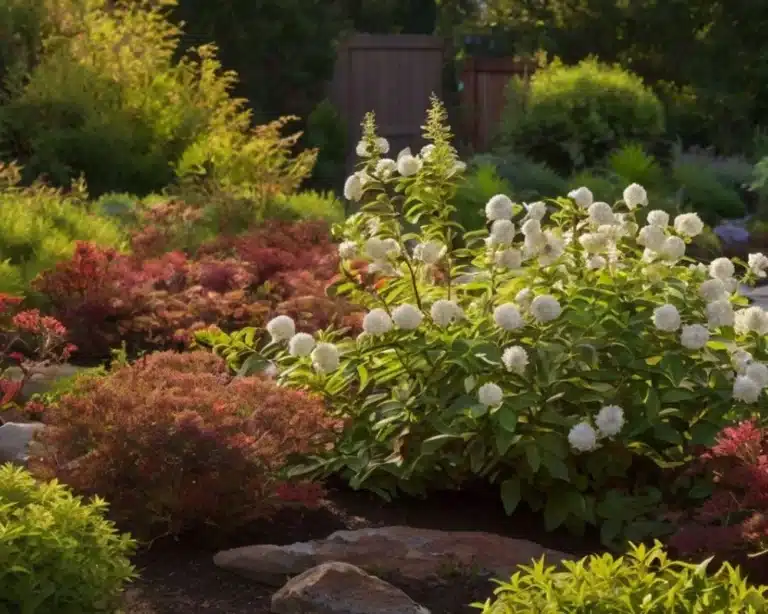
6 thoughts on “Best 7 Striking Types of Shrubs to Transform Your Garden”